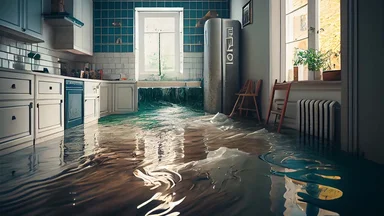Rule of thumb formulas for water damage restoration

- Home
- Insights
- Humidity control and drying insights
- Rule of thumb formulas for water damage restoration
Even for water damage restoration experts with decades of experience, it is nearly impossible to calculate every dehumidification requirement with 100% accuracy.
There are many factors that need to be taken into account in order to determine the best dehumidification load for your water damage restoration project. And while every situation is different, the empirical data below provides a helpful rule of thumb guide to work from.
W refers to the amount of water drawn from the air in grams per hour (g/hour).
V refers to the volume of the room in m3.

Please note that concerning drying out a newly constructed building it all comes down to the specific building materials used for walls, floors and roofs. The water content of various building materials differ so much that a simple rule of thumb would not make sense.
1. Establishing a comfortable indoor climate
If the desired RH-value is to be approx. 50% RH use this formula:
W = V * 2.0 (g/hour)
Example: V = 500m3> W = 2.0 * 500 = 1,000g/hour.
Recommendation: Two AD 935 units. Capacity: 0.69 litre/hour at 20ºC/50% RH.
2. Preserve and protect goods and materials
If the desired RH-value is to be approx. 50% RH use this formula:
W = V * 1.2 (g/hour)
Example: V = 450m3 > W = 1.2 * 450 = 540g/hour
Recommendation: Onw AD 935. Capacity: 0.69 litre/hour at 20ºC/50% RH.
3. Repair water damage
Assuming a drying process of 8-12 days and an average condition of t = 20ºC/50% RH (starting at 60% RH ending at 40% RH) use this formula:
W = V * 4.0 (g/hour)
Example: V = 280m3 > W = 4 * 280 = 1,120g/hour
Recommendation: Three AD 935 S units. Capacity pr. unit: 0.54 litre/hour at 20ºC/50% RH. We recommend that you use S-models with extra air volume and built-in 1kW heaters to encourage the evaporation and speed up the dehumidification process when dealing with water damage.
| Room volume (V) | AD 935 | AD 935 S | AD 955 | AD 975 |
| < 200m3 | 1 units | 2 unit | 1 unit | 1 unit |
| 200m3 - 300m3 | 2 units | 2 units | 2 units | 1 unit |
| 300m3 - 500m3 | 3 units | 4 units | 2 units | 2 units |
| 500m3 - 750m3 | 5 units | 6 units | 3 units | 2 units |
For more advice on water damage restoration and choosing the best system for your requirements, don’t hesitate to get in touch.
Related products
Featured insights

Save time and money on removing moisture from under the floors

This article explains how you can calculate the dehumidification load for your specific settings

Discover everything you need to know about approaching a water damage restoration project.
Need help with choosing the right solution? Our team of over 100 climate control experts can assist.
You can also reach out or join the discussion on our Social Media. Check out our LinkedIn page.




